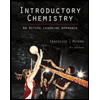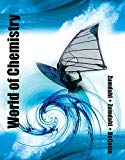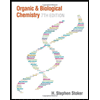
Mastering Chemistry with Pearson eText -- Standalone Access Card -- for Introductory Chemistry (6th Edition)
6th Edition
ISBN: 9780134565927
Author: Nivaldo J. Tro
Publisher: PEARSON
expand_more
expand_more
format_list_bulleted
Concept explainers
Question
Chapter 18, Problem 25E
Interpretation Introduction
Interpretation:
The generic structure of
Concept introduction:
The aldehyde and the ketone are the organic compounds that contain a carbonyl group. The aldehydes are named by dropping the -e from the name of an
Expert Solution & Answer
Want to see the full answer?
Check out a sample textbook solution
Students have asked these similar questions
Pls help me on this q.
Given the elementary reactions in an aqueous medium with an ionic strength of 0.001:1) CH3Br + OH- → CH3OH + Br-2) ClCH2COO- + OH- → HOCH2COO- + Cl-3) [Co(NH3)5Br]2+ + NO2- →[Co(NH3)5NO2]2+ + Br-If the ionic strength is decreased, 1) k will not change; 2) k will decrease; and 3) k will increase. Is this correct?
Relate zero ionic strength and infinite dilution limit.
Chapter 18 Solutions
Mastering Chemistry with Pearson eText -- Standalone Access Card -- for Introductory Chemistry (6th Edition)
Ch. 18 - Prob. 1SAQCh. 18 - Q2. What is the correct formula for the alkane...Ch. 18 - Which structure is not an isomer of...Ch. 18 - Prob. 4SAQCh. 18 - Prob. 5SAQCh. 18 - Name the compound. a. 2-methyI-3-pentene b....Ch. 18 - Prob. 7SAQCh. 18 - Prob. 8SAQCh. 18 - Prob. 9SAQCh. 18 - Prob. 10SAQ
Ch. 18 - Prob. 1ECh. 18 - Prob. 2ECh. 18 - Prob. 3ECh. 18 - 4. What is vitalism? How was vitalism usurped?
Ch. 18 - Prob. 5ECh. 18 - Prob. 6ECh. 18 - Prob. 7ECh. 18 - Prob. 8ECh. 18 - Prob. 9ECh. 18 - Prob. 10ECh. 18 - 11. Explain the difference between n-alkanes and...Ch. 18 - Prob. 12ECh. 18 - Prob. 13ECh. 18 - Prob. 14ECh. 18 - Prob. 15ECh. 18 - What are alkane substitution reactions? Provide an...Ch. 18 - 17. What is an alkene addition reaction? Provide...Ch. 18 - Prob. 18ECh. 18 - Prob. 19ECh. 18 - Prob. 20ECh. 18 - 21. What is the generic structure of alcohols?...Ch. 18 - Prob. 22ECh. 18 - Prob. 23ECh. 18 - Prob. 24ECh. 18 - Prob. 25ECh. 18 - Prob. 26ECh. 18 - Prob. 27ECh. 18 - Prob. 28ECh. 18 - Prob. 29ECh. 18 - Prob. 30ECh. 18 - Prob. 31ECh. 18 - Prob. 32ECh. 18 - Prob. 33ECh. 18 - Prob. 34ECh. 18 - Prob. 35ECh. 18 - Prob. 36ECh. 18 - Prob. 37ECh. 18 - Prob. 38ECh. 18 - Prob. 39ECh. 18 - Prob. 40ECh. 18 - Prob. 41ECh. 18 - Prob. 42ECh. 18 - Prob. 43ECh. 18 - Name each alkane.Ch. 18 - Prob. 45ECh. 18 - 46. Draw a structure for each alkane.
...Ch. 18 - Determine what is wrong with the name of each...Ch. 18 - Determine what is wrong with the name of each...Ch. 18 - Prob. 49ECh. 18 - Prob. 50ECh. 18 - Prob. 51ECh. 18 - Prob. 52ECh. 18 - Prob. 53ECh. 18 - Prob. 54ECh. 18 - Prob. 55ECh. 18 - 56. Name each alkane.
Ch. 18 - Prob. 57ECh. 18 - Prob. 58ECh. 18 - Prob. 59ECh. 18 - 60. Provide correct structures for each compound.
...Ch. 18 - Prob. 61ECh. 18 - Prob. 62ECh. 18 - Prob. 63ECh. 18 - Complete the table.Ch. 18 - Prob. 65ECh. 18 - Prob. 66ECh. 18 - Prob. 67ECh. 18 - Prob. 68ECh. 18 - What are the products of this alkene addition...Ch. 18 - Prob. 70ECh. 18 - Prob. 71ECh. 18 - Prob. 72ECh. 18 - Prob. 73ECh. 18 - Prob. 74ECh. 18 - Name each monosubstituted benzene.Ch. 18 - Prob. 76ECh. 18 - Prob. 77ECh. 18 - Prob. 78ECh. 18 - Prob. 79ECh. 18 - Prob. 80ECh. 18 - Prob. 81ECh. 18 - Prob. 82ECh. 18 - Based on its functional group, match the structure...Ch. 18 - Prob. 84ECh. 18 - Prob. 85ECh. 18 - Prob. 86ECh. 18 - Prob. 87ECh. 18 - Prob. 88ECh. 18 - Prob. 89ECh. 18 - Draw a structure for each alcohol. a. 1-hexanol b....Ch. 18 - Prob. 91ECh. 18 - Prob. 92ECh. 18 - Prob. 93ECh. 18 - For each compound, provide a name if the structure...Ch. 18 - Prob. 95ECh. 18 - Prob. 96ECh. 18 - Prob. 97ECh. 18 - Prob. 98ECh. 18 - Prob. 99ECh. 18 - Prob. 100ECh. 18 - Prob. 101ECh. 18 - Prob. 102ECh. 18 - Identify each organic compound as an alkane,...Ch. 18 - Prob. 104ECh. 18 - 105. Name each compound.
Ch. 18 - Name each compound.Ch. 18 - Prob. 107ECh. 18 - Prob. 108ECh. 18 - Prob. 109ECh. 18 - Prob. 110ECh. 18 - Prob. 111ECh. 18 - How many kilograms of CO2 are produced by the...Ch. 18 - Prob. 113ECh. 18 - Prob. 114ECh. 18 - Prob. 115ECh. 18 - Prob. 116ECh. 18 - Using complete sentences, compare and contrast...Ch. 18 - The octane rating for gasoline is a measurement of...Ch. 18 - Prob. 120QGWCh. 18 - Prob. 121DIA
Knowledge Booster
Learn more about
Need a deep-dive on the concept behind this application? Look no further. Learn more about this topic, chemistry and related others by exploring similar questions and additional content below.Similar questions
- The photolysis of H3C–N=N–C2H5 involves the breaking of the single bonds shown. According to this, in addition to N2, what products would be obtained primarily if the reaction were carried out in the gas phase or in solution in an inert solvent?arrow_forwardGiven a keto-enol tautomerization reaction, which is greatly influenced by the type of solvent, indicate which of the following solvent properties cannot be considered a "solvent effect"?(A) Dielectric constant(B) Polarity(C) Hydrogen bonding capacity(D) Temperaturearrow_forwardIn solution reactions, what does "solvent effect" mean?arrow_forward
- How to solvearrow_forwardIndicate the concentration and ionic strength ranges to which the Debye-Huckel equation can be applied. And the Davies equation?arrow_forwardIf the ionic strength (I) of a solution is very low, the Debye-Huckel equation is used. If I is higher, the Davies equation is used. What is the correct value for I to use one or the other?arrow_forward
- In both the Debye-Huckel equation and the Davies equation, there is a constant A. I see that sometimes it appears as 0.51 and other times as 1.02. Explain why one or the other value is used.arrow_forwardThe two equations are forms of the Davies equation, used in thermodynamics for activity coefficients: ال log Y₁ = -Az² - 0,31 log = Az² - 0,31 1 + √Ĩ 1 + √√ k These equations are consistent and imply that Yi = Is this last equation correct? karrow_forwardThe two equations are forms of the Davies equation, used in thermodynamics for activity coefficients: ال log Y₁ = -Az² - 0,31 log = Az² - 0,31 1 + √Ĩ 1 + √√ k These equations are consistent and imply that Yi = Is this last equation correct? karrow_forward
- For the Davies equation, both expressions are correct: log Y₁ = -Az² √i - 0,31 1 + √ k log- = Az - 0,31 k 1 + √Ĩarrow_forwardk In Davies' equation log y₁ = log- log y₁ = log | = -Az² + ✓// k A is a constant that always equals 1.02. Correct? - 0,31arrow_forwardIndicate whether the equality is true Yi How is it obtained? k%arrow_forward
arrow_back_ios
SEE MORE QUESTIONS
arrow_forward_ios
Recommended textbooks for you
 Introductory Chemistry: An Active Learning Approa...ChemistryISBN:9781305079250Author:Mark S. Cracolice, Ed PetersPublisher:Cengage Learning
Introductory Chemistry: An Active Learning Approa...ChemistryISBN:9781305079250Author:Mark S. Cracolice, Ed PetersPublisher:Cengage Learning World of Chemistry, 3rd editionChemistryISBN:9781133109655Author:Steven S. Zumdahl, Susan L. Zumdahl, Donald J. DeCostePublisher:Brooks / Cole / Cengage Learning
World of Chemistry, 3rd editionChemistryISBN:9781133109655Author:Steven S. Zumdahl, Susan L. Zumdahl, Donald J. DeCostePublisher:Brooks / Cole / Cengage Learning Organic And Biological ChemistryChemistryISBN:9781305081079Author:STOKER, H. Stephen (howard Stephen)Publisher:Cengage Learning,
Organic And Biological ChemistryChemistryISBN:9781305081079Author:STOKER, H. Stephen (howard Stephen)Publisher:Cengage Learning, General, Organic, and Biological ChemistryChemistryISBN:9781285853918Author:H. Stephen StokerPublisher:Cengage Learning
General, Organic, and Biological ChemistryChemistryISBN:9781285853918Author:H. Stephen StokerPublisher:Cengage Learning
 Chemistry: The Molecular ScienceChemistryISBN:9781285199047Author:John W. Moore, Conrad L. StanitskiPublisher:Cengage Learning
Chemistry: The Molecular ScienceChemistryISBN:9781285199047Author:John W. Moore, Conrad L. StanitskiPublisher:Cengage Learning

Introductory Chemistry: An Active Learning Approa...
Chemistry
ISBN:9781305079250
Author:Mark S. Cracolice, Ed Peters
Publisher:Cengage Learning

World of Chemistry, 3rd edition
Chemistry
ISBN:9781133109655
Author:Steven S. Zumdahl, Susan L. Zumdahl, Donald J. DeCoste
Publisher:Brooks / Cole / Cengage Learning

Organic And Biological Chemistry
Chemistry
ISBN:9781305081079
Author:STOKER, H. Stephen (howard Stephen)
Publisher:Cengage Learning,

General, Organic, and Biological Chemistry
Chemistry
ISBN:9781285853918
Author:H. Stephen Stoker
Publisher:Cengage Learning


Chemistry: The Molecular Science
Chemistry
ISBN:9781285199047
Author:John W. Moore, Conrad L. Stanitski
Publisher:Cengage Learning
Chapter 4 Alkanes and Cycloalkanes Lesson 2; Author: Linda Hanson;https://www.youtube.com/watch?v=AL_CM_Btef4;License: Standard YouTube License, CC-BY
Chapter 4 Alkanes and Cycloalkanes Lesson 1; Author: Linda Hanson;https://www.youtube.com/watch?v=PPIa6EHJMJw;License: Standard Youtube License